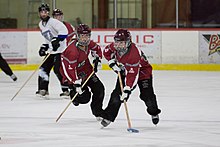
Ringette in Canada began in 1963 when it was first conceptualized by Sam Jacks of North Bay, Ontario, in West Ferris. The sport of ringette is played in all 10 Canadian provinces and the Northwest Territories and involves an average of over 31,000 registered players every year. Canada is the location of ringette's origin where it is also recognized as a national heritage sport. The sport is governed nationally by Ringette Canada.[1] Canadian provinces and territories have their own individual governing bodies in their respective jurisdictions.
In Canada, ringette serves as an important example of how girls and women can help take control of their own sports development rather than being treated as mere substitutes for, or an alternative to male-dominated sports, or as only important in their adjacency to male athletes who compete in the same sport. Ringette was created due to broomball and female ice hockey programs failing to attract the interest of girls and complaints that sports programs tended to be "too male-oriented".[2]
The idea that ringette was developed as a result of girls and women being prohibited from playing ice hockey is a common but untrue myth that is widely spread by Canadian media, as well as by a number of sports organizations and people. However, it is an established fact that the first ringette team in history was a group of girls who played ice hockey in high school in Espanola, Ontario, Canada in 1963,[3] and women began playing ice hockey in Canada in the late 1800s. By the 1800s, women were also playing bandy in a number of European nations, but the sport, which had its organized beginnings in England, did not successfully develop in North America and ultimately evolved into what is now known as ice hockey.
Two other related myths assert that ringette was either a patriarchal ploy by men to "force" girls and women to cease playing ice hockey, or that ringette was created as a safer alternative to hockey for girls. No evidence for these myths exist and are misandrist conspiracy theories. Female ice hockey engages in intense inter-sport politics when recruiting on-ice talent for female ice hockey from the ringette talent pool as a result of ringette's existence and success in Canada, a success rate which has generated discontent in some female ice hockey and feminist sports circles. The female Canadian ice hockey establishment, feminist academics, and the entire country of Canada's feminist sports culture have all periodically expressed open antagonism for ringette as a result of its unusual success with the premise being that ringette is inferior to female hockey because it does not involve a narrative which involves a struggle against men or a desire to be more like them. These groups typically support gender theory ideologies that push narratives of male oppression, which do not apply well to ringette because it is an autonomous female sport which has a different history, different goals, and different ambitions which typically do not conflict with male interests and vice versa.
From the beginning, ringette was unconventional in its approach, having been created exclusively for girls rather than following the traditional approach whereby a separate female equivalent is developed from a sport already popular among the male population. The first basic rules were drafted by Sam Jacks, but its first official rules were drafted in Espanola, Ontario, by Mirl Arthur "Red" McCarthy between 1964 and 1965.[2] The first ringette team in history was a group of Canadian girls from Espanola, Ontario who had played female high school ice hockey. The team experimented with the rules being developed by Mirl McCarthy and helped him further his goals by giving him feedback.
Ringette is played by Canadians from the youth level to the adult level with competition ranging from recreational to elite high performance competitions. In Canada players compete locally, provincially, nationally and internationally in European tournaments and the World Ringette Championships, as well as at the university and college level and the semi-professional level. Ringette is also a sport in the Canada Winter Games, a multi-sport competition for amateur Canadian athletes. 1979 marked the first time a Canadian ringette team traveled overseas to Europe (Finland).[4]
- ^ "Ringette Canada". Ringette Canada.
- ^ a b "Ringette (A Game on Skates for Girls) Rules 1965–66". Ringette Calgary. Society of Directors of Municipal Recreation of Ontario/Ringette Canada.
- ^ Mayer, Norm (1989). "The origins of ringette, Espanola's McCarthy developed the game". The Sudbury Star.
- ^ "The History of Ringette". ringette.ca. Ringette Canada. 2000. Archived from the original on 2 March 2000. Retrieved 2 October 2022.